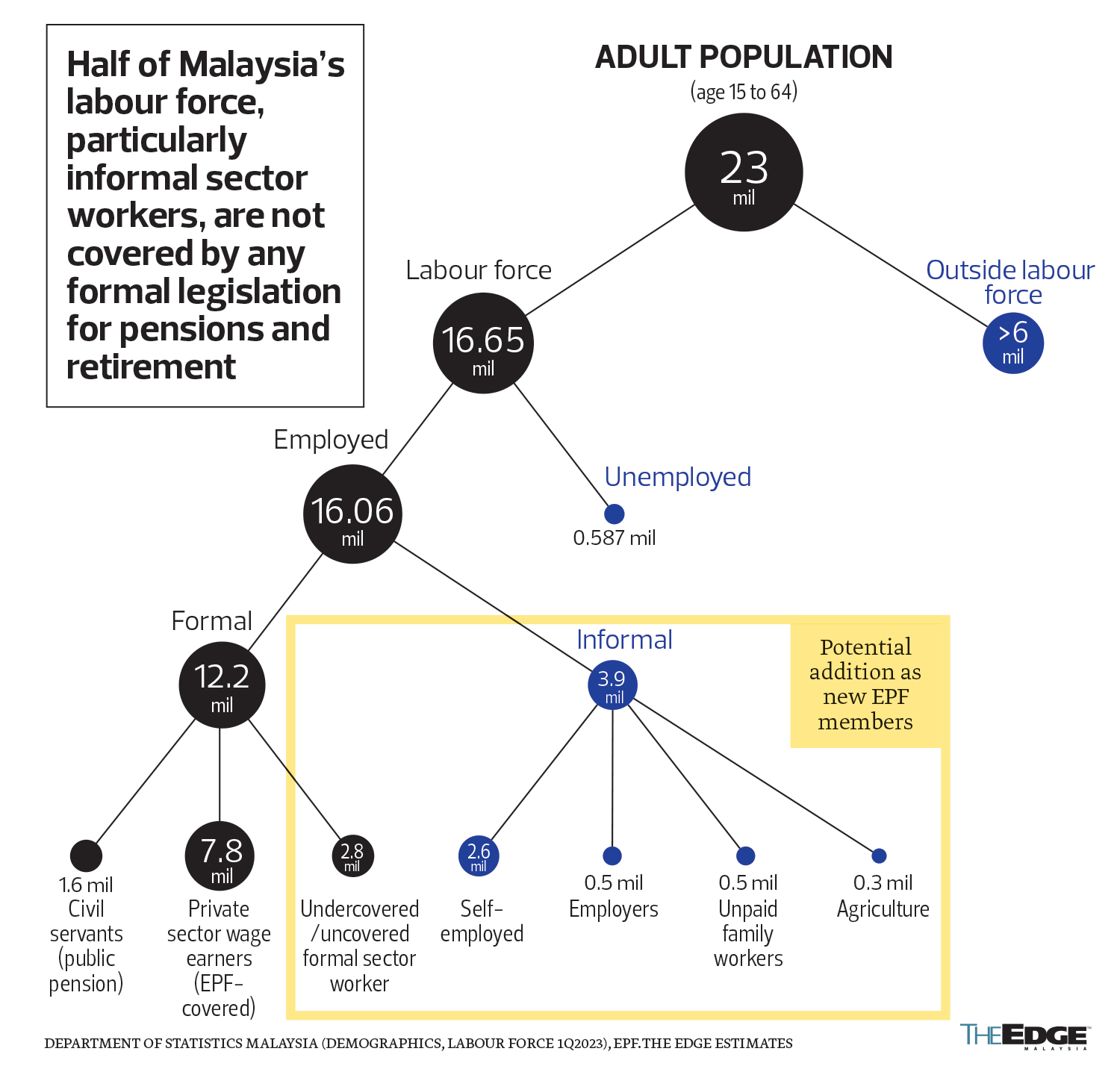
This article first appeared in The Edge Malaysia Weekly on June 19, 2023 - June 25, 2023
THE Employees Provident Fund reported solid numbers for the first quarter of 2023, just as its CEO Datuk Seri Amir Hamzah Azizan had hinted it would in a recent interview with The Edge.
While gross investment income of RM15.6 billion for 1Q was a shade lower quarter on quarter and year on year, the haul was still 11.5% above the five-year average for the quarter of about RM14 billion, The Edge’s records show (see Chart 1).
The RM15.16 billion net investment income (net of RM440 million listed equity write-down but not other expenses and potential impairments) was better than the RM14.7 billion recorded in 1Q2022, when it saw a write-down of RM1.09 billion for listed equities (see Chart 2).
While it is still early to gauge the EPF’s 2023 dividend from its showing in the first three months of the year, the 1Q numbers put it on track to deliver a dividend of around 5% — assuming the performance is kept up for the remaining three quarters of the year, our back-of-the-envelope calculations show.
Its 2Q performance may well be more telling with markets digesting US Federal Reserve chair Jerome Powell’s hawkish pause last week, given that global equities enjoyed a rally in the earlier part of the year ahead of the collapse of Silicon Valley Bank and two other banks in the US, plus the Swiss government-brokered UBS Group AG takeover of Credit Suisse that happened in mid- and late March.
Among other things, Amir said the EPF does not invest in contingent convertible (CoCo) or additional tier-one (AT1) bonds that made the headlines when those of Credit Suisse were wiped out. (Scan QR1 to read the story and QR2 the excerpt from the interview published on June 5, 2023, in which Amir also clarified what Prime Minister Datuk Seri Anwar Ibrahim meant by “70% domestic investments”.)
For the record, the EPF said its overall investment assets increased to RM1.04 trillion as at end-March 2023, of which 37% were overseas assets that the fund said “were mainly in equities [which] continued to outperform and add value to the EPF’s overall return”. Overseas assets contributed RM7.04 billion, “representing 46% of the total investment income recorded” for the quarter (45.1% of gross investment income and 46.4% of net investment income).
The EPF’s domestic investments, which account for 63% of its total assets, “are mainly invested in held-to-maturity fixed income instruments [that] continued to provide long-term income stability through interests and profits”, the fund said in a June 9 statement, adding that it “remains dedicated to supporting and contributing to the growth of the home economy, by continuing to allocate more than 70% of its new investment annual allocation to the domestic market”.
Helped by a steady recovery in labour market conditions as well as ongoing policy support, the EPF not only saw growth in the number of total active members to 8.45 million (53.5% of the overall member base of 15.79 million), but also received RM25.83 billion in (gross) contributions during 1Q2023, “the highest quarterly contributions to date, which surpassed the pre-pandemic figures”.
According to data from 2015 to 2019 previously released by Bank Negara Malaysia, 1Q is traditionally the strongest when it comes to contributions. Gross contributions to the EPF used to exceed withdrawals by at least RM2 billion per quarter, with net contributions (gross contributions minus gross withdrawals) averaging at RM5.3 billion a quarter between 1Q2015 and 1Q2020. Gross withdrawals averaged about RM11.7 billion per quarter during the same period (see Chart 3).
Local investment boost of over RM28 bil?
While the EPF only provided (gross) contribution numbers for the first quarter of 2019 to 2023, and not the corresponding gross withdrawal numbers when releasing its 1Q2023 performance, it is likely that the provident fund is again seeing net contributions this year, in the absence of Covid-19-related special withdrawals totalling RM145.5 billion between April 2020 and May 2022. The latter caused the EPF to have just over RM60 billion more flowing out of the fund than the money entering it collectively in 2021 and 2022. At the time of writing, the EPF had yet to revert on requests for gross withdrawal numbers.
If gross withdrawals remain largely the same as before, the stronger gross contributions the EPF is seeing means that there is potentially RM10 billion to RM13 billion in additional cash per quarter that the EPF can invest both domestically and overseas.
Putting 70% of that money into the domestic market could see roughly RM28 billion to RM36 billion flowing into various asset classes this year.
Going by the EPF’s strategic asset allocation, some RM12 billion to RM16 billion (roughly 45%) could be allocated for the take-up of Malaysian government securities and equivalents with potentially RM10 billion to RM15 billion flowing into domestic equities, our back-of-the-envelope calculations show. The latter is sizeable — 0.6% to 0.9% of Bursa Malaysia’s total market capitalisation of about RM1.7 trillion currently.
This still potentially leaves around RM2 billion for infrastructure and real estate investments that the EPF usually seeks out for a steady income stream as well as a hedge against inflation.
Incentive to join as new EPF member
It would be interesting to see if the EPF can continue to see record-high contribution inflows into the fund or if the 1Q2023 numbers were exceptionally high owing to recent government incentives.
Under Budget 2023 that was re-tabled in February, for instance, the government had reportedly allocated nearly RM1 billion to deposit RM500 each into the Account 1 of some two million EPF members aged between 40 and 54 with a balance of less than RM10,000.
There is also the i-Saraan initiative, meant to encourage workers in the informal sector and Malaysians under 60 without formal income streams to save for their retirement with the EPF. The 15% incentive from the government for i-Saraan was increased from RM250 to RM300 in 2023, which meant that a new EPF member can get the maximum RM300 top-up from the government by depositing RM2,000 under the initiative. Previously, one would get the maximum RM250 top-up from the government by depositing RM1,667 annually.
Malaysians below the age of 60 who are self-employed — including gig economy workers and those not earning a regular salary — can sign up for i-Saraan by registering as a new EPF member, according to the EPF website. That means parents with money to spare can sign up their teenage children early and enjoy that 15% instant return by parking RM2,000 with the EPF and letting the money grow. Even if, say, a 15-year-old does not contribute any more money to the EPF, that RM2,300 will increase in 30 years to more than RM10,000 by the time he or she is 46 years old, and exceed RM16,000 by age 56 — a far better position than the two million EPF members for whom the government has allocated close to a billion ringgit to top up savings. That is assuming the EPF continues to pay a 5% dividend year after year.
According to the EPF, i-Saraan recorded 62,952 registrations in 1Q2023, raising the total number of i-Saraan members to 997,659 as at end-March this year — a 67% increase from 598,874 as at end-March 2022. The 62,952 new EPF members under i-Saraan make up 54% of the 116,423 new EPF member registration for 1Q. Assuming all of them deposited at least RM2,000 to each enjoy the maximum RM300 incentive from the government, there should have been an inflow of about RM145 million from those 62,952 new i-Saraan members alone in 1Q2023. If the 934,707 who signed up for i-Saraan before 1Q2023 all deposited RM1,667 per person to receive RM250 each from the government, the EPF would have seen an inflow of RM1.8 billion.
At 997,659, the number of EPF members who came on board via i-Saraan represent roughly 11.8% of the 8.45 million active members (defined as members who had contributed at least one time in the past 12 months) that the EPF had as at end-March this year, and 6.3% of the 15.79 million total (active and inactive) EPF members.
In his interview with The Edge, Amir reiterated the EPF’s concern that more than 40% of Malaysia’s 16.65 million workforce, particularly in the informal sector, are neither covered by any form of formal legislation for pension and retirement nor have adequate social protection (see graphic). This, he says, is why the EPF — on top of managing its investment portfolio to ensure sustainable returns for members — is also actively going out to register new members outside the private-sector wage earners in the formal sector who must make statutory contributions to the EPF.
“The informal sector is an important target for us. What we’ve been doing on the ground is going out, trying to convince those working in the informal sector that it is important for them to think about their retirement and start putting in money [with the EPF],” Amir told The Edge, acknowledging that the government incentive helped convince people to come on board.
“People without incentive are a bit slow. So, the i-Saraan scheme was also enhanced so that people who have the capacity would want to do it [sign up],” he said, relating how EPF mobile teams are reaching out to dispatch drivers, fishermen and agricultural entrepreneurs to tell them that they need not be an employee to qualify as an EPF member because it is about building retirement savings.
“We will be working with the government to strengthen the mechanism to make it much more formulative as opposed to just going out and getting voluntary contributions. But we will need to undergo the legislative mechanism to sort this out,” Amir noted.
If the EPF manages to sign up a million more members from the informal sector, there is a potential inflow of RM1 billion, even if each only contributes RM1,000.
While having a bigger fund size means it would be tougher to generate every 1% of dividend for its members, there are funds bigger than the EPF outside Malaysia with more than RM1 trillion under management that can continue to generate decent returns, Amir told The Edge.
“The reality is that the EPF looks at its role as part and parcel of the solution for social protection in Malaysia. If you want to do that, you must get coverage in a better form here.”
Save by subscribing to us for your print and/or digital copy.
P/S: The Edge is also available on Apple's App Store and Android's Google Play.




